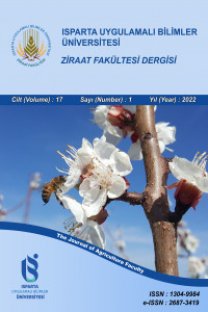Batı Akdeniz Bölgesi Domates Güvesi Tuta absoluta (Lepidoptera: Gelechiidae) Popülasyonlarında Endosimbiyont Bakteri Türlerinin Belirlenmesi
Çalışma kapsamınsa, Batı Akdeniz Bölgesi’nde Antalya, Muğla, Isparta ve Burdur illerinden 11 lokasyondan toplam 55 adet Domates güvesi Tuta absoluta (Meyrick) (Lepidoptera: Gelechiidae) bireyi toplanmıştır. Söz konusu böcek türünde endosimbiyont bakterilerden Wolbachia, Rickettsia ve Spiroplasma taraması yapılmıştır. Bu bireylerde endosimbiyont bakteri olan Wolbachia, Rickettsia ve Spiroplasma’nın varlığı ve bulunma oranı PCR reaksiyonlarından sekans yapılarak belirlenmiştir. Sonuç olarak, Rickettsia ve Spiroplasma’nın T. absoluta için dünya ve Türkiye genelinde ilk kayıt olduğu belirlenmiştir. Bu zamana kadar bulunamayan Spiroplasma ve Rickettsia çalışmamızda yüksek oranda değer göstermiştir. Batı Akdeniz Bölgesi’nde Domates güvesinde Wolbachia, Ricketsia ve Spiroplasma bulunma oranları sırasıyla %76.3, %78.1 ve %90.9 olarak belirlenmiştir.
Anahtar Kelimeler:
Tuta absoluta, Endosimbiyont bakteri, Wolbachia, Ricketsia, Spiroplasma
Determination of Endosymbiont Bacteria Species of Tomato Leafminer Tuta absoluta (Lepidoptera: Gelechiidae) Populations from the West Mediterranean Region
Within the scope of the study, a total of 55 tomato leafminer Tuta absoluta (Meyrick) (Lepidoptera: Gelechiidae) individuals were collected from 11 locations in the provinces of Antalya, Muğla, Isparta and Burdur in the Western Mediterranean Region. Wolbachia, Rickettsia and Spiroplasma from endosymbiont bacteria were screened in the insect species in question. The presence and rate of endosymbiont bacteria Wolbachia, Rickettsia and Spiroplasma in these individuals were determined by sequencing from PCR reactions. As a result, it was determined that Rickettsia and Spiroplasma were the first records for T. absoluta in the world and Turkey. Spiroplasma and Rickettsia, which could not be found until now, showed high value in our study. In the region, the presence ratios of Wolbachia, Ricketsia and Spiroplasma were determined as 76.3%, 78.1% and 90.9%, respectively.
Keywords:
Tuta absoluta, Endosymbiont bacteria, Wolbachia, Ricketsia, Spiroplasma,
___
- Anderson, C. L., & Karr, T. L. (2001). Wolbachia: evolutionary novelty in rickettsial bacteria. BMC Evolutionary Biology, 1(10). https://doi.org/10.1186/1471-2148-1-10
- Anonim (2014). Tuta absoluta Zirai Mücadele Teknik Talimatı. Erişim adresi http://www.tarim.gov.tr/tagem/menu/28/ yayinlar_veriler.www.bku.tarim.gov.tr
- Biondi, A., Guedes, R. N. C., Wan, F. H., & Desneux, N. (2018). Ecology, worldwide spread, and management of the invasive South American tomato pinworm, Tuta absoluta: past, present, and future. Annual review of entomology, 63, 239-258. https://doi.org/10.1164/annurev-ento-031616-034933
- Chen, S. J., Lu, F., Cheng, J. A., Jiang, M. X., .& Way, M. O. (2012). Identification and Biological Role of the Endosymbionts Wolbachia in Rice Water Weevil (Coleoptera: Curculionidae). Environmental Entomology, 41(3), 469-477. https://doi.org/10.1603/EN11195
- Kontsedalov, S., Fein, E. Z., Chiel, E., Gottlieb, Y., Inbar, M., & Ghanim, M. (2008). The presence of Rickettsia is associated with increased susceptibility of Bemisia tabaci (Homoptera: Aleyrodidae) to insecticides. Pest Management Science, 64(8), 789-792. https://doi.org/10.1002/ps.1595
- Li, Q., Fan, J., Sun, J. X, Wang, M. Q., & Chen J. L. (2018).Effect of the secondary symbiont Hamiltonella defensa on fitness and relative abundance of Buchnera aphidicola of wheat aphid, Sitobion miscanthi. Frontiers in Microbiol, 9, 582. https://doi.org/10.3389/fmicb.2018.00582
- Liu, X. D., & Guo, H. F. (2019). Importance of endosymboints Wolbachia and Rickettsia in insect resistance development. Current Opinion in Insect Science, 33, 84-90. https://doi.org/10.1016/j.cois.2019.05.003
- Mehrkhou, F., Güz, N., Korkmaz, E. M., & Çağatay, N. S. (2021). Analysis of genetic variation in an important pest, Tuta absoluta, and its microbiota with a new bacterial endosymbiont. Turkish Journal of Agriculture and Forestry, 45(1), 111-123. https://doi.org/10.1371/journal.pone.0079368
- Paredes, J. C., Herren, J. K., Schüpfer, F., Marin, R., Claverol, S., Kuo, C. H., Lemaitre, B., & Béven, L. (2015). Genome sequence of the Drosophila melanogaster male-killing Spiroplasma strain MSRO endosymbiont. MBio, 6(2), 14. https://doi.org/10.1128/mBio.02437-14
- Roditakis, E., Skarmoutsou, C., Staurakaki, M., del Rosario Martínez-Aguirre, M., García-Vidal, L., Bielza, P., Haddi, K., Rapisarda, C., Rison, J. L., Bassi, A., & Teixeira L. A. (2013). Determination of baseline susceptibility of European populations of Tuta absoluta (Meyrick) to indoxacarb and chlorantraniliprole using a novel dip bioassay method. Pest Management Science, 69(2), 217-227. https://doi.org/10.1002/ps.3404
- Tsuchida, T., Koga R., & Fukatsu T. (2004) Host plant specialization governed by facultative symbiont. Science, 303(5666), 1989-1989. https://doi.org/10.1126/science. 1094611
- Shokal, U., Yadav, S., Atri, J., Accetta, J., Kenney, E., Banks, K., Kataham, A., Jaenike, J., & Eleftherianos, L. (2016). Effects of co-occurring Wolbachia and Spiroplasma endosymbionts on the Drosophila immune response against insect pathogenic and non-pathogenic bacteria. BMC Microbiology, 16(1), 1-13. https://doi.org/10.1186/s12866-016-0634-6
- Su, J., Chow, B., Boulianne, G. L., & Wilde, A. (2013). The BAR domain of amphiphysin is required for cleavage furrow tip-tubule formation during cellularization in Drosophila embryos. Molecular Biology of the Cell, 24(9), 1444-1453. https://doi.org/10.1091/mbc.e12-12-0878
- Yalçın, M., Mermer, S., Kozaci, L. D., & Turgut, C. (2015). Insecticide resistance in two populations of Tuta absoluta (Meyrick, 1917) (Lepidoptera: Gelechiidae) from Turkey. Türkiye Entomoloji Dergisi, 39(2), 137-145. https://doi.org/10. 16970/ted.63047
- ISSN: 1304-9984
- Yayın Aralığı: Yılda 2 Sayı
- Başlangıç: 2006
- Yayıncı: Isparta Uygulamalı Bilimler Üniversitesi
Sayıdaki Diğer Makaleler
Domateste Kök Ur Nematodu Mücadelesinde Kitosanın Toprak ve Yaprak Uygulamaları
Fatma Gül GÖZE ÖZDEMİR, Tuğçe ÖZEK, Jean Claude NDAYIRAGIJE, Hacer ÇEVİK, İsmail KARACA
İlknur YURDAKUL, Kadriye KALINBACAK, Dilek ALTINKAYNAK, Remzi Murat PEKER
Caner YALMANLI, Sabri ERBAŞ, Murat MUTLUCAN
Bazı Beef Tipi Domates Hatlarının Morfolojik Özelliklerinin Belirlenmesi
Firooz Ahmad NIKZAD, Hasan BAYDAR
Türkiye’de Sığır Eti Üretiminin ARIMA (Box-Jenkins) Modeli ile Öngörüsü
Aslı DALGIÇ, Deniz SARICA, Vecdi DEMİRCAN
Basınçlı Sulama Sistemlerinin COPAM Yazılımı ile Performans Analizi: Burdur Çavdır-Küçükalan Örneği
